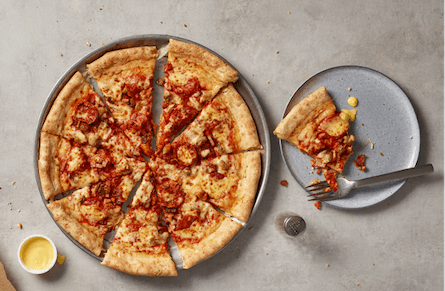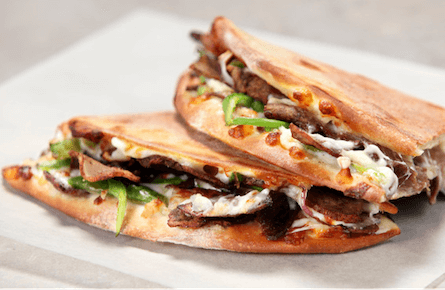10 MIN READ
A slice of history: The real story of pizza
When it comes to the world of pizza, we certainly know a thing or two. Our passion isn’t just about making delicious pies – but also shedding light on the flavourful origins of pizza that make it such a global phenomenon.
Because here at Papa Johns, we aren't just pizza makers, we’re pizza lovers. We’re well-versed in the history and traditions that make this delicious dish as beloved as it is. From its ancient origins to its now global popularity, the tale of pizza offers a true slice of culture and community. So, sit back and savour this tasty tour through the history of pizza. Just don’t blame us if you’re craving a slice – or three! – by the end.

Your slice-by-slice guide
- The early origins of pizza
- The Italian pizza revolution
- The American pizza dream
- When did pizza come to the UK?
- Why is pizza called pizza?
- Pizza innovations
The early origins of pizza
The story of pizza stretches back much further than you might think, long before Italy stamped its culinary authority on this dish. It actually begins in ancient civilisation, where flatbreads served as a staple in many diets.
How was pizza invented?
Historical records and archaeological findings suggest many ancient societies such as the Greeks, Egyptians, and Romans all consumed various forms of flatbreads. And the Persians were reportedly doing it as far back as 6th century BC.
It’s thought they used flatbread bases as edible plates for other foods. The flatbread plates made eating more practical and minimised waste. After all, these were the days before dishwashers! Over time, these early flatbreads started gaining culinary stature as people began adding spices and herbs, transforming them into a delicious and standalone dish.
The type of toppings depended on the availability of local produce, meaning different eras and regions all had their own distinct flavour profiles. As well as herbs and spices, people starting using vegetables, fish, and small pieces of game on their ancient pizzas. Olive oil was particularly popular, especially among Mediterranean cultures.
Even the methodology for applying toppings evolved, from casually scattering them, to artistic arrangements that would maximise both taste and visual appeal. These were the ancient beginnings of pizza.
What country was pizza invented in?
The modern version of pizza was invented in Italy. So, while the ancient Romans may have had a hand in the very first ancient ‘pizzas’, it took a few more centuries for these topped flatbreads to become the pizzas we know and love today.
The Italian pizza revolution
Where was the first pizza made?
Naples is often considered the birthplace of modern pizza. The vibrant street food culture in 18th century Naples provided a perfect backdrop for the evolution of pizza from basic flatbread to culinary sensation.
Poverty was rampant, and people needed cheap food that was easy to eat. Pizza filled this void, sold by street vendors and simple pizzerias. But what really set Neapolitan pizza apart from its ancestors was the use of tomato as a topping, a New World ingredient that found its true culinary calling on the doughy canvas of a pizza.

Who invented the pizza?
While the invention of pizza can’t quite be attributed to one person due to its unique evolution – local pizzaiolo Raffaele Esposito is one name we can associate with the invention of the modern pizza. He helped elevate pizza from street food to a dish of royal acclaim.
In 1889, Queen Margherita of Savoy visited Naples, and local pizzaiolo Raffaele Esposito was tasked with creating something special. He chose to use ingredients that would represent the colours of the Italian flag: red tomatoes, white mozzarella, and green basil. The Queen was so impressed that she sent a thank you note, and thus, Margherita pizza became an overnight sensation, not only in Italy but – eventually – all over the world.

The American pizza dream
Before pizza went global, America was next to discover its delights. When Italian immigrants set foot on American soil, they brought with them their rich culinary heritage, including, of course, pizza.
Initially, pizza was mainly consumed within immigrant communities. However, it soon extended well beyond these enclaves, thanks to its versatility and tastiness.
The post-World War II era saw an explosion of pizzerias, especially in cities like New York and Chicago, each with its own interpretation of what a pizza should be. The 1950s gave us the rise of pizza chains, and pizza soon became a true part of American culture.
Just a few decades later, 1984 to be exact, Papa Johns opened its doors for the first time in Jeffersonville, Indiana. This came at a time when pizza popularity was reaching new heights – a popularity that still hasn’t waned to this day.
America’s take on pizza
America is a land of diverse tastes and culinary traditions – and that’s clear to see when you consider all the different types of regional pizza the States has to offer.
While New York pizza is known for its thin, crisp yet foldable crust, Chicagoans swear by their deep-dish pizzas filled with cheese, meat, and chunky tomato sauce. Detroit brings its own square-shaped, pan-baked style into the mix. And then there's California, a place where pizza becomes a canvas for culinary experimentation, often featuring gourmet and unconventional toppings.
These may seem a little far removed from the original Neapolitan pizzas – but America’s love for the Italian dish definitely helped establish pizza as a global icon.
Pizza goes global
When did pizza come to the UK?
Pizza's introduction to the UK happened mainly in the post-WWII era when Britan was undergoing big cultural changes.
The first official record of pizza being sold in Britain is at the Olivelli restaurant in Bloomsbury, London in 1934 (a margherita, of course – in case you’re wondering). But it wasn’t until a couple of decades later that pizza really took off, with pizzerias opening around the country.
Shortly after, pizza began to change the dining landscape in the UK. It broke free from the confines of sit-down restaurants and became a household staple perfect for takeaway and delivery. This shift was a game-changer, especially for busy families and the younger generation – and this helped propel pizza to an even wider audience.
The international take on pizza
Outside of Italy, it’s not just the UK and the US where pizza has made its mark. Whether it's a seafood-laden pizza in Japan, a Hawaiian variant in Australia, or a spicy Mexicana in Latin America, each country has put their own culinary twist on this classic dish. In India, you might find a Paneer Tikka pizza, while in Sweden, the Kebab Pizza is a popular choice.
There aren’t many dishes that have a true universal appeal – but pizza is definitely one of them. Just don’t ask which country has the best pizza as that debate could get more heated than the average pizza oven!

The name game: Why is pizza called pizza?
The origin of the word “pizza” is as rich and varied as the dish itself. The word was first officially recorded in English in the early 1800s and there a few theories of how “pizza” became known as “pizza”.
The term may originate from the Italian word “pinza”, a derivation of the Latin word “pinsere” which means to pound or stamp. Another theory suggests that it derives from the Greek word “pitta”, which means cake or pie.
Alternative names for pizza
While the name “pizza” is definitely recognised worldwide, there are some other names for the iconic dish.
In Italy, you might hear someone refer to a pizza as a “pizzetta” for a smaller version. While in the United States the term “pie” is often used to refer to a whole pizza – as is the lesser-known slang “za”. And if you fold a pizza in half, you can call that a “calzone” – or, a “papadias” as we like to call them at Papa Johns.
Whatever you want to call pizza – one thing we can all agree on is that it’s delicious!

Modern pizza innovations
The evolution of pizza doesn’t stop there. As the world has changed, pizza has followed. Nowadays, you can find gluten-free bases, vegan pizza options, and a plethora of vegetable toppings that cater to different dietary needs. and a plethora of vegetable toppings that cater to different dietary needs.
And when it comes to pizza takeaway, technology has revolutionised the pizza delivery experience. Online and app ordering means you don’t even have to pick up the phone anymore, the choice to create your own pizza has unlocked unlimited topping opportunities, and with real-time tracking you'll know exactly when dinner while arrive.
The final slice
From the ancient pizzas of Persia to the modern pizzas of Papa Johns – who knew a simple flatbread could evolve into a global phenomenon? Remember that next time you place an order for some pizza – you’re not just getting a meal, but a true slice of history.
Feeling a little hungry after all of that? Check out our latest deals and offers and find your nearest Papa Johns.

Sources
https://www.italymagazine.com/dual-language/origins-pizza
https://www.historytoday.com/archive/historians-cookbook/history-pizza
https://www.rd.com/article/who-invented-pizza/
https://www.history.com/news/a-slice-of-history-pizza-through-the-ages
https://www.tastingtable.com/1240393/margherita-pizza-royalty/
https://www.foodandwine.com/travel/restaurants/regional-american-pizza-styles
https://inside.papajohns.co.uk/careers/history/
https://warwick.ac.uk/fac/arts/history/ghcc/blog/a_quick_british/
https://www.spectator.co.uk/article/a-slice-of-history-how-did-britain-s-pizza-industry-begin/
https://www.theguardian.com/lifeandstyle/2003/feb/09/foodanddrink.features12
https://www.dictionary.com/e/whats-the-origin-of-pizza/
https://www.merriam-webster.com/dictionary/pizzetta


